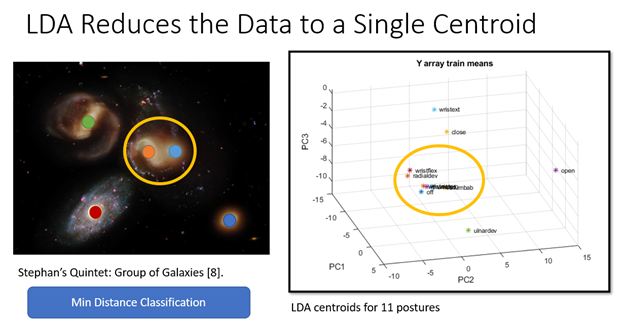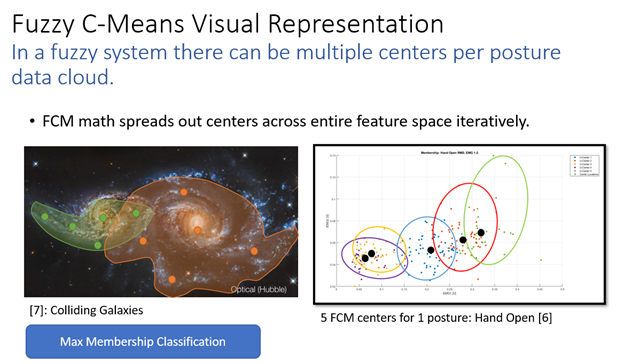Machine Learning for Prosthetic Hands
Pattern Recognition systems are used to train the system to recognize what different grasp patterns look like in the multi EMG domain each time they are performed. All pattern recognition algorithms take different mathematical approaches to look for features to identify unique characteristics for each grasp pattern.
We are looking into researching and comparing the clinical standard of care: Linear Discriminant Analysis (LDA) to other types of machine learning algorithms such as Fuzzy C-Means (FCM). LDA and FCM both use dimensionality reduction techniques, but FCM uses more than one centroid per dataset. We hypothesize that by fitting a posture dataset to multiple centroids instead of condensing it down to one, we can gain additional information for separating postures more accurately.
How does the clinical standard, Linear Discriminant Analysis (LDA), work?
LDA is a dimensionality reduction technique used in supervised machine learning. LDA classifies data by projecting multidimensional data into one dimension and finding the within-class scatter and the between class-scatter as shown in Figure 1. LDA aims to minimize within-class scatter and to maxmize the between-class scatter to separate the datasets and allow for accurate classification.

Figure 19: Good and bad LDA projections can be seen here. Projecting the datasets onto the vertical axis in this case does not separate the classes at all, making it impossible to classify to either dataset accurately. By projecting the data onto the horizontal axis, complete separation of the datasets are observed. This will allow for the system to accurately classify to one dataset or the other. Projecting to the horizontal axis here maximizes the between class scatter while minimizing the within-class scatter.
LDA works in pattern recognition algorthims for prosthetic devices by assigning a centroid to each individual posture and classifiying the data as it relates to these centroids. Figure 2 uses Stephan's Quintet to better explain this theory. Each galaxy in Stephan's Quintet has 1 centroid. The distances of the individual stars from the centroids are measured and they are classified finding the centroid they are closest to.

Figure 28: LDA mathematically transforms features into a new principal component space to maximize between class separation and minimize within class scatter. Once this is done, a single centroid for each cluster or posture is computed.
How does Fuzzy C-Means (FCM) work?
Fuzzy C-Means (FCM) differs from LDA in that it uses multiple centroids for each dataset, or in our case, each individual posture. Using more than one centroid per posture allows the algorithm to better capture the features from the entire dataset, which could potentially improve classification accuracy. Figure 3, again, explains this theory with a galaxy metaphor, showing how the shape of the actual galaxy can be better captured using more than one centroid. Relating this back, using more than one centroid will allow us to capture more of the feature space for each individual posture to get a more accurate picture of the data.

Figure 36,7: Fuzzy C-Means spreads out multiple centers across an asymmetrical dataset to capture the entire feature space rather than reducing down to one centroid.
Why is an FCM algorithm an interesting alternative to LDA?
Any pattern recognition system works well when hand postures are very different from each other. For example, "wrist flexion" and "hand open" use completely different sets of flexor and extensor muscles. However, when postures are similar, such as "hand close" and "thumb adduction", the algorithms often get confused because there is usually overlap in which muscles are recruited to perform the posture.FCM is an interesting alternative because we may be able to separate similar postures whose LDA centroids would normally clump together and make it difficult to separate by the minimum distance. When we have multiple centers represent 1 posture, we gain information on the whole spatial area which may include non-linearities. Unfortunately, when the posture is reduced to 1 centroid we discard this potentially useful information. Our research aims to see if adding more centers to the machine learning algorithm can allow the system to separate similar postures better and improve classification accuracies for prosthetic hand control systems.
Why is Pattern Recognition beneficial?
In theory, a Pattern Recognition system should help the myoelectric hand be more intiuitive to operate as the user would just need to think of performing the desired posture and the controller would be able to switch to that posture immediately. This may benefit users in being able to achieve natural continuous sequential control instead of having to cycle through all patterns as in a State Machine. Therefore, this may help increase embodiment for the user to decrease prosthesis rejection rates.
References
- Moore, KL.; Dalley, AF. 4th. Lippincott Williams & Wilkins; Baltimore (MD): 1999. Clinically oriented anatomy.
- Ajiboye, A. B., & Weir, R. F. ff. (2005). A Heuristic Fuzzy Logic Approach to EMG Pattern Recognition for Multifunctional Prosthesis Control. IEEE Transactions on Neural Systems and Rehabilitation Engineering, 13(3), 280–291. https://doi.org/10.1109/tnsre.2005.847357
- Farrell, T. R. (2011). Determining delay created by multifunctional prosthesis controllers. The Journal of Rehabilitation Research and Development,48(6), Xxi. doi:10.1682/jrrd.2011.03.0055
- Young, A. J., Smith, L. H., Rouse, E. J., & Hargrove, L. J. (2013). Classification of Simultaneous Movements Using Surface EMG Pattern Recognition. IEEE Transactions on Biomedical Engineering,60(5), 1250-1258. doi:10.1109/tbme.2012.2232293
- Roche, A. D., Rehbaum, H., Farina, D., & Aszmann, O. C. (2014). Prosthetic Myoelectric Control Strategies: A Clinical Perspective. Current Surgery Reports, 2(3). https://doi.org/10.1007/s40137-013-0044-8
- Lorelli, S. A. (2020). Predicting Prosthetic Finger Postures Via Parallel Fuzzy C-Means Classification (master’s thesis). ProQuest Dissertations Publishing. Retrieved April 21, 2023, from https://www.proquest.com/openview/495a495851b64a8c8ed8ae1d2fd1a487/1?pq-origsite=gscholar&cbl=18750&diss=y.
- NASA, ESA, & Bacon, G. (2018, April 23). NASA scientific visualization studio - colliding galaxies (NGC 2207). Scientific Visualization Studio. Retrieved April 21, 2023, from https://svs.gsfc.nasa.gov/30941
- NASA, ESA, Bacon, G., DePasquale, J., Summers, F., & Levay, Z. (2019, January 15). NASA scientific visualization studio - Stephan's quintet. Scientific Visualization Studio. Retrieved April 21, 2023, from https://svs.gsfc.nasa.gov/31019
- Raschka, S. (2014, August 03). Linear Discriminant Analysis. Retrieved April 21, 2018, from http://sebastianraschka.com/Articles/2014_python_lda.html
